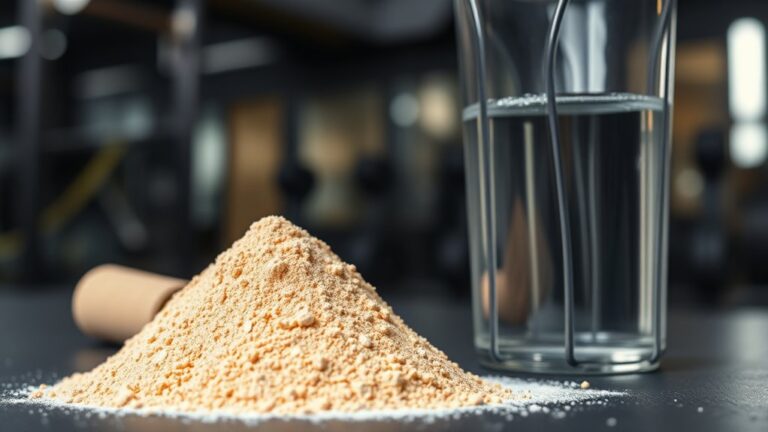The Science of Creatine and Its Effects on Gym Performance
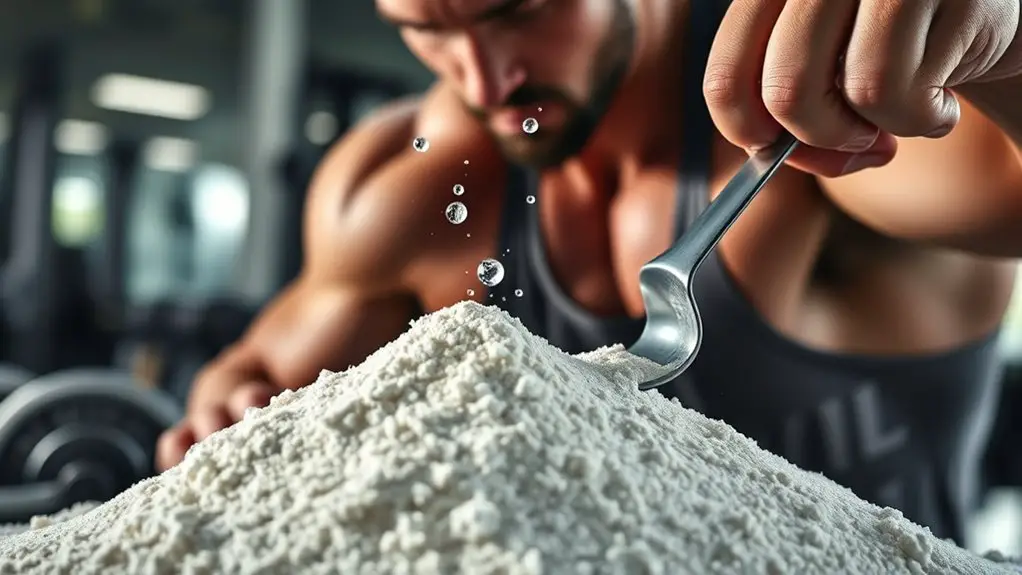
Creatine’s key role in gym performance lies in its ability to boost strength, power output, and recovery during high-intensity workouts. It increases ATP availability, allowing you to perform more repetitions and recover faster between sets. Various creatine forms can suit different needs, but proper supplementation, adequate hydration, and a balanced diet are essential for maximum effectiveness. Understanding these mechanics can help you optimize your workouts for better results, as you’ll discover more insights ahead.
What Is Creatine and How Does It Work?
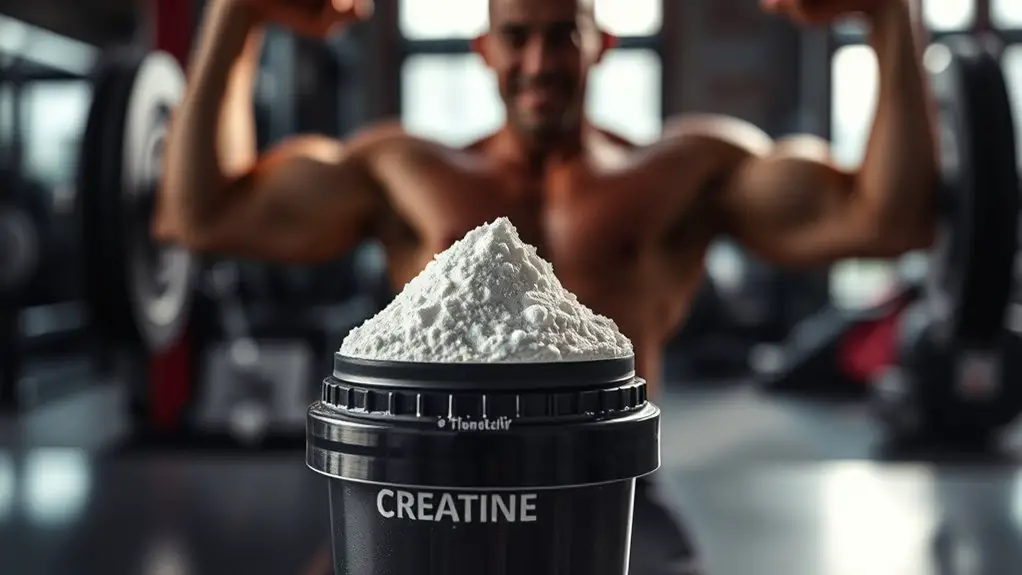
Creatine is a naturally occurring compound found in small amounts in certain foods and synthesized in the body from amino acids. The primary creatine sources include red meat and fish, which provide the building blocks essential for its production. Once ingested, creatine enters your bloodstream and is transported to muscles, where it plays a critical role in energy metabolism.
In your muscles, creatine undergoes metabolism, converting into phosphocreatine. This compound serves as a rapid energy reserve during high-intensity activities, such as sprinting or heavy lifting. When your body requires quick bursts of energy, phosphocreatine donates a phosphate group to adenosine diphosphate (ADP), regenerating adenosine triphosphate (ATP). ATP is the primary energy carrier in your cells, essential for muscle contractions. Understanding creatine’s role in energy metabolism can help you make informed decisions about your training and nutrition.
The Benefits of Creatine for Strength and Power
When you incorporate creatine into your routine, you can expect to see notable improvements in muscle strength and power output. This supplement not only enhances your performance during high-intensity workouts but also aids in quicker recovery times between sessions. Understanding these benefits can help you make informed decisions about your training regimen.
Enhanced Muscle Strength
Although many supplements claim to enhance athletic performance, few have shown as much promise in boosting muscle strength and power as creatine. When you incorporate creatine into your strength training regimen, you may experience significant gains in muscle hypertrophy. This improvement occurs because creatine increases the availability of adenosine triphosphate (ATP), your muscles’ primary energy source. As a result, you can perform more repetitions at higher intensities, leading to enhanced muscle overload and growth. Additionally, creatine aids in faster recovery between sets, allowing you to train harder and more frequently. This combination of increased workload and effective recovery can result in greater overall strength gains, making creatine a valuable ally in your fitness journey.
Increased Power Output
While many athletes seek ways to maximize their performance, few supplements rival creatine’s ability to enhance power output during high-intensity exercises. Creatine’s role in ATP production is vital for power training, allowing you to generate more explosive strength in shorter bursts. This increased energy availability means you’re able to lift heavier weights or perform more explosive movements, which is essential for athletes engaged in sports requiring rapid power output. Studies consistently show that creatine supplementation can lead to significant improvements in your ability to perform high-intensity tasks, translating into better overall performance in the gym. By incorporating creatine into your regimen, you can maximize your training efficiency and achieve your power goals more effectively.
Faster Recovery Times
Building on the benefits of increased power output, faster recovery times are another significant advantage of creatine supplementation. When you enhance your creatine absorption, you’re effectively replenishing your energy stores more quickly after intense workouts. This means you’re less likely to experience prolonged muscle soreness, allowing you to stick to your training schedule without significant interruptions. Incorporating creatine into your recovery protocols can optimize your post-workout nutrition, helping to restore ATP levels and support muscle repair. As a result, you can train harder and more frequently, ultimately leading to improved strength and performance over time. By prioritizing faster recovery through creatine, you’ll enhance your overall gym experience and achieve your fitness goals more efficiently.
Creatine and Muscle Recovery: A Closer Look
When considering how creatine impacts muscle recovery, it’s essential to understand its role in replenishing energy stores and reducing muscle damage. During intense workouts, your muscles rely on ATP, which depletes quickly. Creatine helps boost creatine metabolism, allowing for faster ATP replenishment. This means you can recover more efficiently between sets or after strenuous sessions.
Additionally, creatine has anti-inflammatory properties that may aid in minimizing muscle soreness and damage. By incorporating creatine into your recovery protocols, you might experience less downtime and improved overall performance. Studies suggest that those using creatine report a quicker return to baseline muscle function following intense exercise.
Ultimately, by enhancing your muscle recovery processes, creatine enables you to train harder and more frequently. This can lead to better results over time, making it a valuable addition to your fitness regimen.
Different Forms of Creatine: Which One Is Right for You?
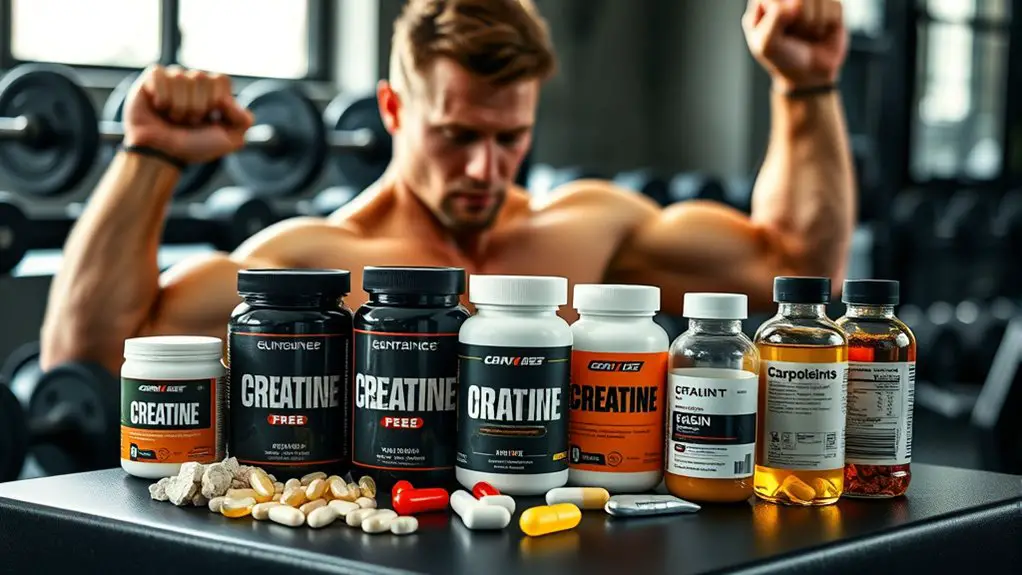
After understanding how creatine can enhance muscle recovery, it’s important to explore the various forms of creatine available on the market. Each creatine type has unique absorption rates and benefits, making it essential to choose the right one for your goals.
Here’s a quick comparison of popular creatine types:
| Creatine Type | Absorption Rate |
|---|---|
| Creatine Monohydrate | High |
| Creatine Ethyl Ester | Moderate |
| Buffered Creatine | High |
| Creatine Hydrochloride | Very High |
| Micronized Creatine | High |
Creatine monohydrate is the most researched and cost-effective option. If you’re looking for quicker absorption, consider creatine hydrochloride or ethyl ester. Ultimately, your choice should align with your specific fitness goals and lifestyle preferences. Testing different forms may help you determine which works best for you.
How to Properly Supplement With Creatine
When it comes to supplementing with creatine, understanding the right dosage and timing can greatly impact your results. Typically, a daily dose of 3 to 5 grams is recommended for maintenance, but adjusting based on your training intensity might be beneficial. Timing your intake around workouts can also enhance its effectiveness, ensuring you’re maximizing your performance gains.
Dosage Recommendations
To effectively supplement with creatine, understanding the right dosage is crucial for maximizing its benefits. Most users start with a loading phase of 20 grams per day, split into four doses for about five to seven days. Afterward, a maintenance dose of 3 to 5 grams per day is typically sufficient. However, it’s important to tailor this to your individual needs, as factors like body weight and training intensity can affect your requirements. Some people prefer cycling protocols, where they alternate periods of supplementation with breaks to maintain creatine sensitivity. Always consult with a healthcare professional before starting any supplementation, especially if you have pre-existing conditions, to guarantee you’re using creatine safely and effectively.
Timing Strategies
While the dosage of creatine is vital, timing your supplementation can greatly enhance its benefits. For optimal results, consider pre workout timing; taking creatine about 30-60 minutes before your workout can boost your energy levels and improve performance. This timing allows your body to utilize the creatine during intense exercise, maximizing its effects.
On the other hand, post workout timing also plays an important role. Consuming creatine immediately after your workout can help replenish your muscles and accelerate recovery. Pairing it with a source of carbohydrates and protein can enhance absorption and effectiveness. Ultimately, whether you choose pre or post workout timing—or a combination of both—pay attention to how your body responds to find the best strategy for your performance goals.
Common Myths and Misconceptions About Creatine
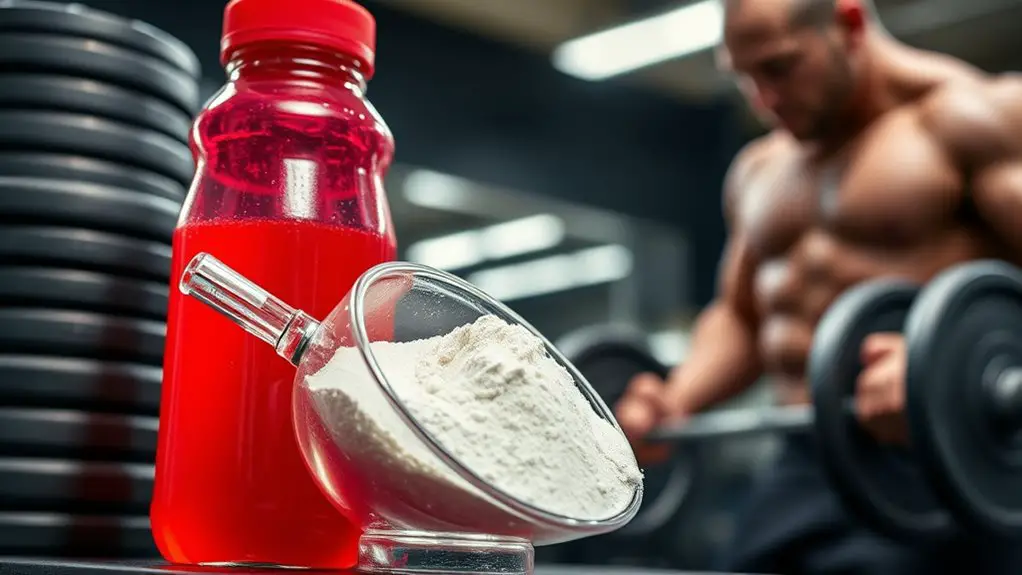
Although many athletes and gym-goers swear by creatine for enhancing performance, a host of myths and misconceptions can cloud its true benefits. One common myth is that creatine is unsafe; however, studies consistently demonstrate its safety when used as directed. You may have heard that it causes dehydration or kidney damage, but research shows these claims are largely unfounded, especially when considering creatine sources like meat and fish, which naturally contain this compound.
Another misconception is that creatine is only for bodybuilders or elite athletes, but it’s beneficial for anyone looking to improve strength and endurance. Some also believe that you must cycle creatine, but continuous use is effective and safe. By debunking these myths, you can better understand how creatine can fit into your fitness routine, helping you achieve your goals without unnecessary fear or confusion.
The Role of Diet and Hydration in Creatine Effectiveness
Diet and hydration play an essential role in maximizing the effectiveness of creatine supplementation. To fully benefit from creatine, you need to guarantee you’re consuming adequate dietary sources of carbohydrates and proteins. These macronutrients help increase insulin levels, which can enhance creatine uptake in your muscles. Foods like lean meats, fish, and dairy are great sources, but combining them with carb-rich foods can amplify results.
Hydration strategies are equally important. Creatine draws water into your muscle cells, so if you’re dehydrated, you may not experience its full benefits. Aim for consistent water intake throughout the day, especially before, during, and after workouts. A good guideline is to drink at least half your body weight in ounces of water daily. By optimizing your diet and hydration, you’ll not only improve creatine’s effectiveness but also enhance your overall gym performance.
Who Can Benefit Most From Creatine Supplementation?
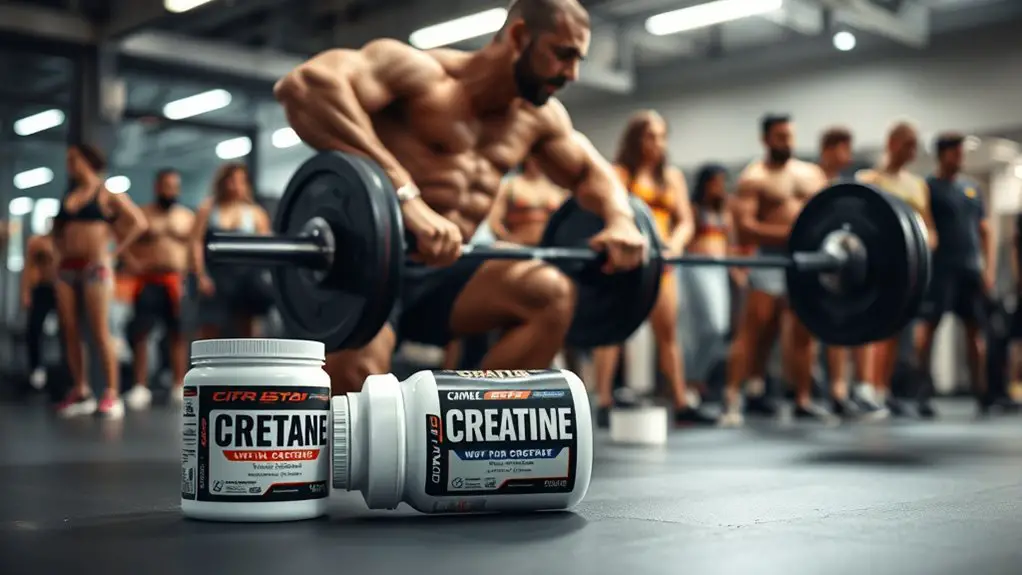
Maximizing creatine’s benefits through proper diet and hydration sets the stage for understanding who can gain the most from its supplementation. Generally, athletic populations engaging in high-intensity training and explosive sports see significant advantages. Age groups also play an essential role; younger athletes often experience enhanced performance, while older adults might benefit from improved muscle mass and strength retention.
| Athletic Population | Age Group | Benefits |
|---|---|---|
| Weightlifters | 18-30 years | Increased strength and power |
| Sprinters | 18-30 years | Enhanced speed and explosiveness |
| Bodybuilders | 18-30 years | Improved muscle growth and recovery |
| Endurance athletes | 30-50 years | Better muscle recovery and stamina |
| Older adults | 50+ years | Preservation of muscle mass and function |
Ultimately, understanding your specific goals and needs will help you determine if creatine supplementation is right for you.
Frequently Asked Questions
Can Creatine Be Used by Vegetarians or Vegans?
Absolutely, creatine can be used by vegetarians or vegans. While most creatine sources come from animal products, there are vegan-friendly options available, such as synthetic creatine supplements. As a vegetarian athlete, you might find that supplementing with creatine can enhance your performance, especially since plant-based diets typically contain lower levels of this compound. Just make sure to choose high-quality supplements to maximize your benefits and support your training goals effectively.
Does Creatine Cause Weight Gain?
You might think creatine’s just a one-way ticket to the weight gain express, but it’s a bit more nuanced. Sure, it can lead to water retention, giving you that initial bump on the scale. However, this isn’t just fluff; it often accompanies muscle hypertrophy, meaning you’re gaining muscle, not just water weight. So, while you may see an increase in weight, it’s not necessarily a bad thing for your fitness goals.
Is Creatine Safe for Teenagers?
When considering if creatine’s safe for teenagers, it’s important to evaluate the potential benefits and risks. Teenage athletes may benefit from creatine, particularly in sports requiring explosive strength. However, it’s essential to stick to recommended creatine dosage to minimize any risks. While research suggests it’s generally safe, consulting a healthcare professional before starting any supplement is always wise. Remember, a balanced diet and proper training should be the foundation of any athletic performance.
How Long Does It Take to See Results From Creatine?
When you’re considering creatine, patience pays off. Typically, you’ll start noticing results within 2 to 4 weeks, depending on your routine and diet. The timing of your creatine intake can influence these result expectations. Consistent use alongside a solid workout plan can maximize benefits, leading to improved strength and endurance. So, stay committed, track your progress, and remember that results come with time and dedication, not overnight miracles.
Can I Take Creatine With Other Supplements?
Yes, you can take creatine with other supplements, but it’s important to evaluate potential creatine interactions and supplement compatibility. Many athletes stack creatine with protein powders, beta-alanine, or branched-chain amino acids (BCAAs) for enhanced performance. However, make sure to monitor how your body responds, and consult a healthcare professional if you’re unsure. Doing so can help you optimize your regimen and avoid any negative effects from combining different supplements.




